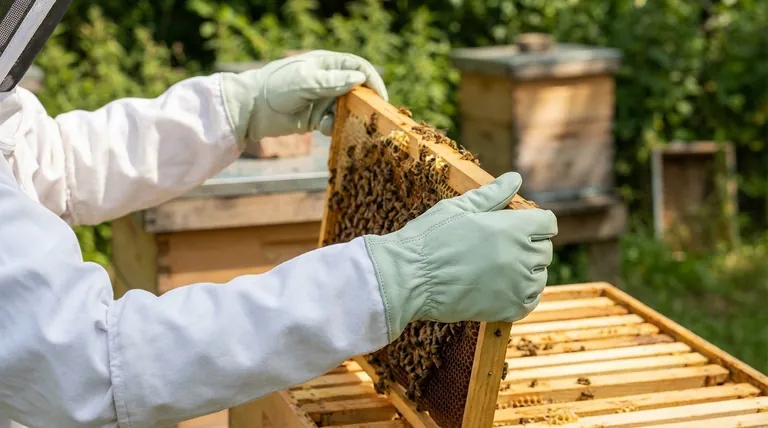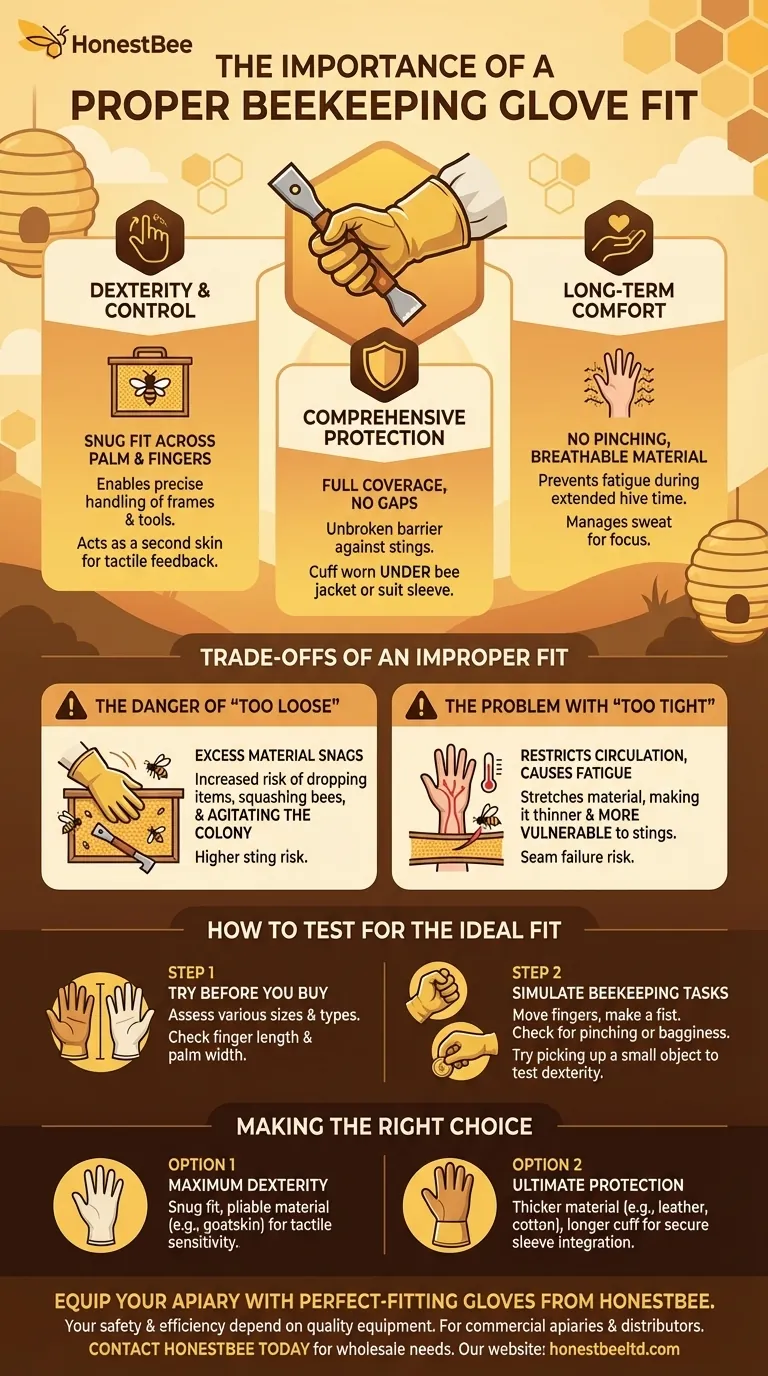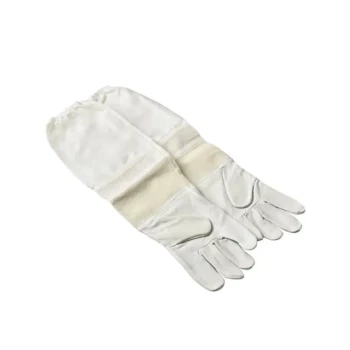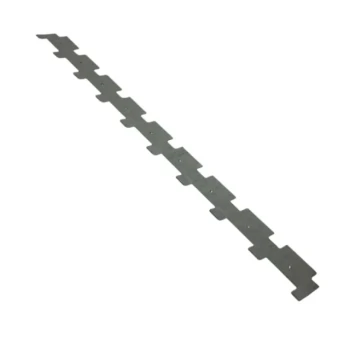A proper beekeeping glove fit is one that is snug enough to allow for precise movements but not so tight that it restricts circulation or causes discomfort. The ideal glove provides full coverage of the hands and wrists while maximizing your dexterity, enabling you to handle delicate frames and tools with confidence and control.
The fit of your beekeeping gloves is not a matter of simple comfort; it is a critical component of your safety and effectiveness. A proper fit directly translates to better control, which minimizes the risk of stings and allows you to work calmly and precisely within the hive.

The Three Pillars of a Perfect Glove Fit
Choosing the right glove requires balancing protection, control, and comfort. These three elements are entirely dependent on achieving the correct fit for your hands.
Pillar 1: Dexterity and Control
The primary function of a well-fitting glove is to act as a second skin, not a clumsy barrier. You need to be able to feel and manipulate frames, tools, and even the queen cage with precision.
A snug fit across the palm and fingers is essential for this tactile feedback and control, preventing you from accidentally dropping a frame or harming your bees.
Pillar 2: Comprehensive Protection
Beekeeping gloves must provide a complete, unbroken barrier against stings. This starts with a fit that leaves no gaps.
The gloves should offer full coverage over your hands and wrists, extending up the forearm. For a secure seal, the glove's cuff should be worn under the sleeve of your bee jacket or suit.
Pillar 3: Long-Term Comfort
You may spend considerable time in your hives, and ill-fitting gloves can lead to fatigue and distraction. The right fit is one you can wear for extended periods without issue.
The glove should not pinch your fingers when you make a fist, and it must be breathable enough to manage sweat, ensuring you can remain focused on your bees.
Understanding the Trade-offs of an Improper Fit
Choosing the wrong size is one of the most common mistakes new beekeepers make. Both overly loose and overly tight gloves introduce significant problems.
The Danger of "Too Loose"
Excess material in a glove that is too large is a serious liability. It can easily snag on hive components or get caught between frames.
This clumsiness increases the likelihood of dropping tools, squashing bees, and agitating the colony, which in turn dramatically raises your risk of getting stung.
The Problem with "Too Tight"
Gloves that are too tight restrict blood flow, leading to hand fatigue and numbness during inspections.
Furthermore, a tight fit stretches the material, making it thinner and potentially more vulnerable to a bee's stinger. This constant tension can also cause the seams to fail prematurely.
How to Test for the Ideal Fit
You cannot determine the right fit by looking at gloves online. You must assess them with your own hands to ensure they meet your needs.
Try Before You Buy
Whenever possible, try on different sizes and types of gloves from various manufacturers. Pay close attention to the length of the fingers and the width of the palm.
Simulate Beekeeping Tasks
Once you have a pair on, move your fingers and make a fist. Check for any pinching or excessive bagginess.
Try to pick up a small object, like your hive tool or a coin, to accurately assess how much dexterity the gloves truly offer.
Making the Right Choice for Your Goal
Your final decision should align with your beekeeping style and priorities.
- If your primary focus is maximum dexterity: Choose a snug-fitting glove made from a thinner, more pliable material like goatskin that allows for the greatest tactile sensitivity.
- If your primary focus is ultimate protection: Opt for a thicker leather or cotton glove with a longer cuff, ensuring it integrates perfectly and securely under your suit sleeve.
Ultimately, the right gloves feel like a natural extension of your hands, empowering a calmer, safer, and more confident beekeeping experience.
Summary Table:
| Aspect of Fit | Ideal Characteristic | Why It Matters |
|---|---|---|
| Dexterity & Control | Snug across palm and fingers | Enables precise frame and tool handling, prevents accidents |
| Protection | Full coverage, no gaps, cuff under sleeve | Creates a complete sting barrier for hands and wrists |
| Comfort | No pinching, breathable material | Reduces fatigue for long hive inspections |
| Too Loose | Avoid excess material | Prevents snagging, dropping frames, and agitating bees |
| Too Tight | Avoid restricted circulation | Prevents hand fatigue and material strain/weakness |
Equip Your Apiary with Perfect-Fitting Gloves from HONESTBEE
Your safety and efficiency in the hive depend on quality equipment that fits correctly. For commercial apiaries and distributors, having a reliable supply of durable, well-fitting gloves is essential for smooth operations.
HONESTBEE specializes in supplying high-quality beekeeping supplies and equipment through wholesale-focused operations. We provide the durable, precision-fit gloves your business needs to keep your teams safe and productive.
Contact HONESTBEE today to discuss your wholesale needs and ensure your beekeepers have the best-fitting protection.
Visual Guide

Related Products
- Beekeeping Gloves Goatskin Leather with Long Cotton Sleeve for Beekeepers
- Goatskin Leather Beekeeper Gloves with Vent Long Sleeve for Beekeeping Honey Bee Sting Proof Protection
- Goat Skin Leather Bee Sting Proof Beekeeping Gloves with Canvas Sleeve
- Mesh Ventilated 3 Layer Goatskin Beekeepers Gloves for Beekeeping
- Professional Galvanized Hive Strap with Secure Locking Buckle for Beekeeping
People Also Ask
- Should beekeepers wear gloves, and why? Essential Protection for Beekeepers
- Why do some experienced beekeepers choose not to wear gloves? For Superior Dexterity & Hive Welfare
- Why is dexterity and flexibility important in beekeeping gloves? Boost Your Hive Management Efficiency
- What is the safest way to handle frames in beekeeping? Master Gentle Handling for a Calm Hive
- What is the difference between cleaning cow leather and goat leather beekeeping gloves? Tailor Your Care for Longevity



















